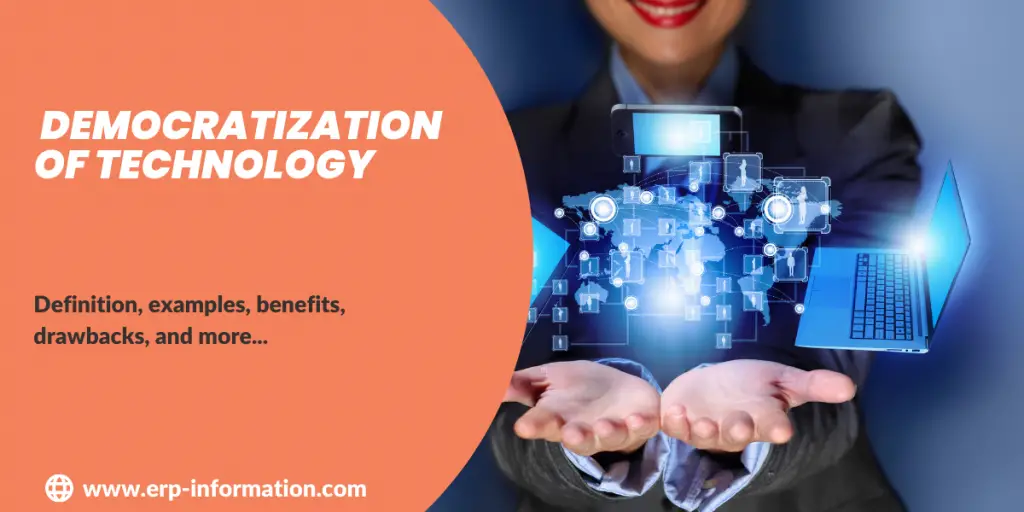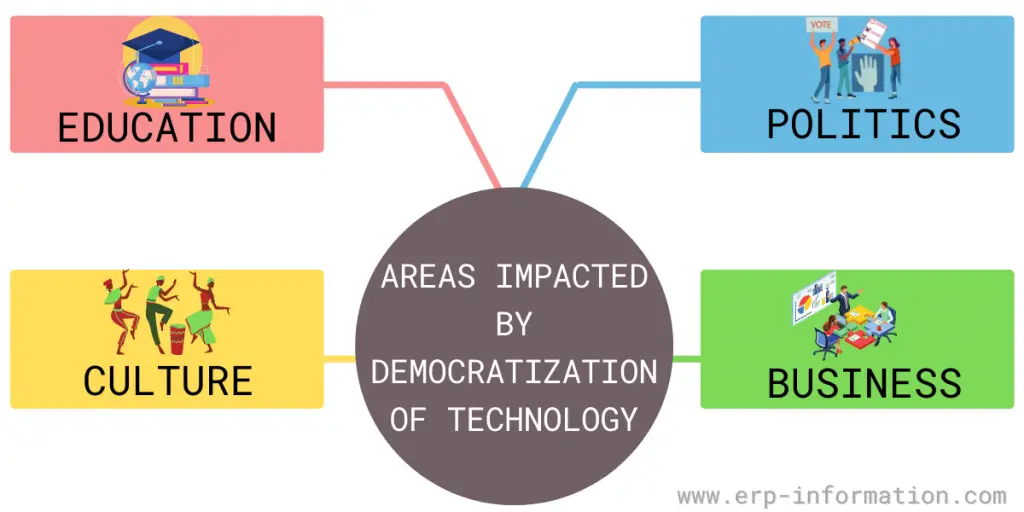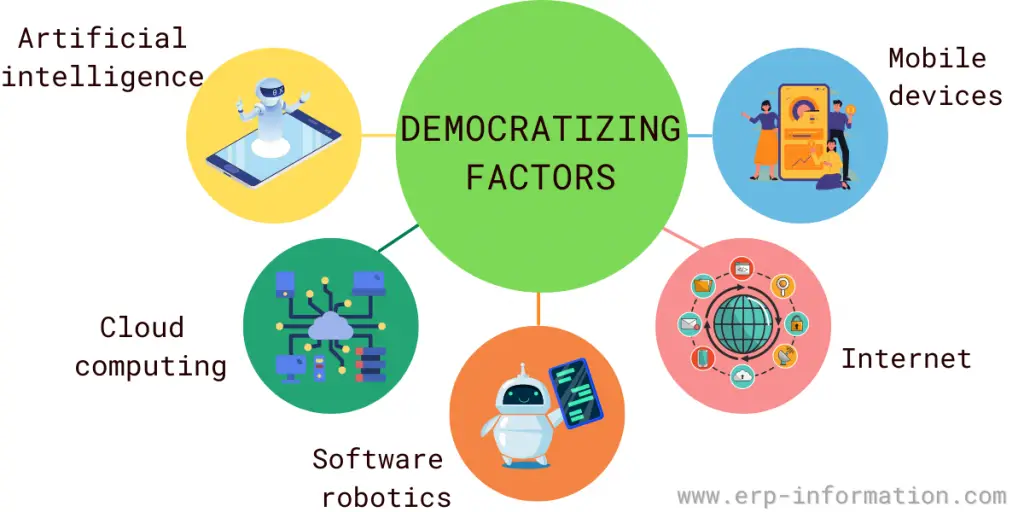In the past few decennia, technology has come a long way. It has gone from being only available to the wealthy and powerful to something now accessible to everyone. That is because of the democratization of technology.
This blog post will define the term democratization of technology, some examples of how it has been used over the years, its benefits, and its drawbacks. We will also explore technology democratization’s impact on different areas.
Democratization of Technology Definition
It is the process by which technology is made more accessible to everyone. That can be done in various ways, including making it more affordable, easier to use, or providing more access.
Democratization of Technology Examples
Technology democratization has been happening for centuries, but it has picked up steam in the past few decades. That is because of several factors, including the invention of the internet and the rise of mobile devices.
Example 1
One of the earliest examples of the democratization of technology is the printing press. Johannes Gutenberg invented the printing press in the 15th century, which allowed books to be printed and made available to the public.
That was a significant advancement, allowing more people to access information.
Example 2
One more example of the democratization of technology is how computers have become more affordable and accessible to the public.
In the past days, only the wealthy could afford to own a computer. Now, many different types of computers are available at various price points. They are also becoming easier to use, with many people figuring them out without assistance.
Example 3
Another example is the way that information is now more easily accessible online. Now anyone can find information with internet access on any topic they are interested in.
This was not always the case. For example, there was a time when only those who could afford to purchase books or subscribe to magazines could access information like this.
How does technology democratization impact different areas?
Democratizing Technology has significantly impacted various areas, including education, politics, business, and culture.
Education
One of the most notable impacts of the democratization of technology has been on education. Technology has allowed for a more level playing field in education.
Before the advent of technology, those who could afford to attend exclusive schools or universities had a significant advantage in getting ahead.
With the help of an internet connection, everyone is getting educational resources for free. That has led to more people getting educated and gaining the skills they need to succeed in the modern world.
Politics
Let us discuss the impact on politics. With affordable technology, more people started participating in the political process. It has also allowed more citizen access and share ideas. The political impact led to more democracy and transparency in government.
Business
The democratization of technology has also had a significant impact on business. It has allowed companies to reach a wider audience and sell their products and services worldwide.
It has also allowed businesses to operate more efficiently using automation and other digital tools.
Culture
Social media platforms have allowed people to connect and share their cultures. It has also led to the rise of new forms of culture, such as online communities and digital art. This has made the world a more diverse and interesting place.
Democratizing factors in business
Artificial intelligence
One of the most notable democratizing factors in business is artificial intelligence. Artificial intelligence is a technology that allows business processes to automate tasks and make decisions.
It has traditionally been very expensive, but it is becoming more affordable as it becomes more widely used.
Cloud computing
Another democratizing factor in business is cloud computing. Cloud computing allows companies to access powerful computer resources without investing in their infrastructure. That has made it possible for small businesses to compete with larger businesses.
Software robotics
Robotics are increasingly being used to automate mundane, time-consuming tasks typically performed by humans.
Internet
The internet is another major democratizing factor in business. It has allowed businesses to reach a global audience and sell their products and services worldwide.
It has also allowed businesses to operate more efficiently using automation and other digital tools.
Mobile devices
Mobile devices have allowed businesses to reach a wider audience and sell their products and services anywhere in the world.
They have also allowed businesses to operate more efficiently using automation and digital transformation.
Benefits of democratizing technologies in industries
Enhanced employee productivity
It provides employees with more skilled tools. For example, artificial intelligence can be used to automate tasks and make decisions. That helps employees to focus on more productive tasks.
Innovation
The internet has allowed businesses to reach a global audience and sell their products and services worldwide.
So that leads to the start of new businesses and the development of new products and services. The no-code platform also allows people with no coding skills to build and launch their businesses.
Increased agility and efficiency
Automation and other digital tools can help businesses operate more efficiently. For example, robotics can be used to automate tasks typically performed by humans. This can help businesses save time and money.
Increased customer satisfaction
One of the main goals of technology democratization is to increase customer satisfaction. Technology democratization provides employees with the tools and resources to do their jobs effectively. That leads to increased productivity and happier customers.
Drawbacks of democratization of technologies
Inequality
One of the main limitations is that it can lead to the development of new forms of inequality. For example, as technology becomes more affordable and accessible, those who can afford it will have an advantage over those who cannot.
Negative impact on society
Another drawback is that it can be used to exploit people. For example, social media can be used to spread fake news or propaganda. That can have a negative impact on society.
No privacy
A big downside of technology’s democratization is that people share too much personal information. In addition, information technology becoming increasingly accessible to the average person, and there is a growing concern over privacy and security.
Many people are unaware of the risks of sharing personal information online. However, as technology evolves, it will become more accessible for people to access and share personal information. That leads to a loss of privacy for individuals and organizations.
Negative impact on employment
The democratization of technology can have a negative impact on jobs. For example, artificial intelligence can be used to automate tasks that humans typically perform. This can lead to job losses and increased unemployment.
IT Democratization Technology
IT democratization is a way for people who don’t have professional training to create new automation tools and applications. This is important because different companies have different ways of doing things. In addition, democratized solution development allows companies to make specific processes without pre-made templates.
Advantages of IT Democratization
- Software development by using democratization reduces the cost and makes the process quicker.
- Companies that spend less on software can use it to get machines to do more work. This makes their work faster and better.
- Companies can save money when they design new products and get them out faster. This will help them stay ahead of other companies in the market.
Challenges of IT Democratization
- Limited flexibility of tools: The main challenge of IT democratization is that its tools are not very flexible. These tools are called low-code/no-code tools. If a company needs to build something complicated like an app, bot, or machine learning model, then no code tools may not be the best solution.
- Not possible to move to different platforms: No code tools make special kinds of code that no one else can use. Companies can’t move their apps, robots, or machine learning models to different platforms if they have been using a no-code tool. So they will be stuck with the same tool after making something with it.
How far do we have to go?
Although much progress has been made in democratizing technology, there is still a long way to go. Particularly evident in the field of education.
Many schools around the world still have not adopted technology into their classrooms. Unfortunately, this means that students are often not learning how to use technology and are not being exposed to its many benefits.
One more area where there is room for improvement is accessibility. Not all technologies are created equal, and some are still not accessible to everyone. Easy access to technology may take some time.
For example, visually impaired people often have difficulty using technologies that require screens or graphics. That needs to change if we want to achieve true democratization of technology.p
FAQs
What is the future of the Democratization of Technology?
The future of technology democratization is likely to be driven by advances in artificial intelligence and mobile technologies.
Artificial intelligence will become more affordable and accessible, allowing businesses to automate tasks and make decisions.
Mobile technologies will continue to become more sophisticated and allow companies to reach a wider audience.
Conclusion
The democratization of technology has brought about many changes in how we live and work. It has enabled people to access information and communication tools that were once only available to a select few.
You can see more and more examples of how democratization is changing lives for the better all over the world.
The post covered the definition, examples, benefits, and drawbacks of the democratization of technology. We hope this post helped you understand the term and its implications.


